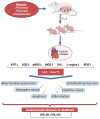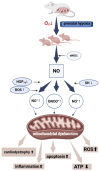Molecular and Biochemical Mechanisms of Cardiomyopathy Development Following Prenatal Hypoxia-Focus on the NO System
- PMID: 40563375
- PMCID: PMC12189570
- DOI: 10.3390/antiox14060743
Molecular and Biochemical Mechanisms of Cardiomyopathy Development Following Prenatal Hypoxia-Focus on the NO System
Abstract
Prenatal hypoxia (PH) adversely affects the development of the fetal heart, contributing to persistent cardiovascular impairments in postnatal life. A key component in regulating cardiac physiology is the nitric oxide (NO) system, which influences vascular tone, myocardial contractility, and endothelial integrity during development. Exposure to PH disrupts NO-related signaling pathways, leading to endothelial dysfunction, mitochondrial damage, and an escalation of oxidative stress-all of which exacerbate cardiac injury and trigger cardiomyocyte apoptosis. The excessive generation of reactive nitrogen species drives nitrosative stress, thereby intensifying inflammatory processes and cellular injury. In addition, the interplay between NO and hypoxia-inducible factor (HIF) shapes adaptive responses to PH. NO also modulates the synthesis of heat shock protein 70 (HSP70), a critical factor in cellular defense against stress. This review emphasizes the involvement of NO in cardiovascular injury caused by PH and examines the cardioprotective potential of NO modulators-Angiolin, Thiotriazoline, Mildronate, and L-arginine-as prospective therapeutic agents. These agents reduce oxidative stress, enhance endothelial performance, and alleviate the detrimental effects of PH on the heart, offering potential new strategies to prevent cardiovascular disorders in offspring subjected to prenatal hypoxia.
Keywords: HSP70; NO modulators; cardiomyocyte apoptosis; cardiomyopathy; endothelial dysfunction; mitochondrial dysfunction; nitrosative stress; oxidative stress; prenatal hypoxia.
Conflict of interest statement
The authors declare no conflicts of interest.
Figures


Similar articles
-
A systematic review of p53 regulation of oxidative stress in skeletal muscle.Redox Rep. 2018 Dec;23(1):100-117. doi: 10.1080/13510002.2017.1416773. Epub 2018 Jan 3. Redox Rep. 2018. PMID: 29298131 Free PMC article.
-
Dexrazoxane for preventing or reducing cardiotoxicity in adults and children with cancer receiving anthracyclines.Cochrane Database Syst Rev. 2022 Sep 27;9(9):CD014638. doi: 10.1002/14651858.CD014638.pub2. Cochrane Database Syst Rev. 2022. PMID: 36162822 Free PMC article.
-
Effects of a gluten-reduced or gluten-free diet for the primary prevention of cardiovascular disease.Cochrane Database Syst Rev. 2022 Feb 24;2(2):CD013556. doi: 10.1002/14651858.CD013556.pub2. Cochrane Database Syst Rev. 2022. PMID: 35199850 Free PMC article.
-
Interventions affecting the nitric oxide pathway versus placebo or no therapy for fetal growth restriction in pregnancy.Cochrane Database Syst Rev. 2023 Jul 10;7(7):CD014498. doi: 10.1002/14651858.CD014498. Cochrane Database Syst Rev. 2023. PMID: 37428872 Free PMC article.
-
Iodine supplementation for women during the preconception, pregnancy and postpartum period.Cochrane Database Syst Rev. 2017 Mar 5;3(3):CD011761. doi: 10.1002/14651858.CD011761.pub2. Cochrane Database Syst Rev. 2017. PMID: 28260263 Free PMC article.
Cited by
-
Current Perspectives on Rehabilitation Following Return of Spontaneous Circulation After Sudden Cardiac Arrest: A Narrative Review.Healthcare (Basel). 2025 Jul 30;13(15):1865. doi: 10.3390/healthcare13151865. Healthcare (Basel). 2025. PMID: 40805898 Free PMC article. Review.
References
-
- Narohan M.V., Bazhenova L.K., Kapranova E.I., Melnikova E.V., Belousova N.A. Posthypoxic Dysfunction of the Cardiovascular System in Newborns. Curr. Issues Pediatr. 2007;6:42–46. (In Ukranian)
Publication types
LinkOut - more resources
Full Text Sources

